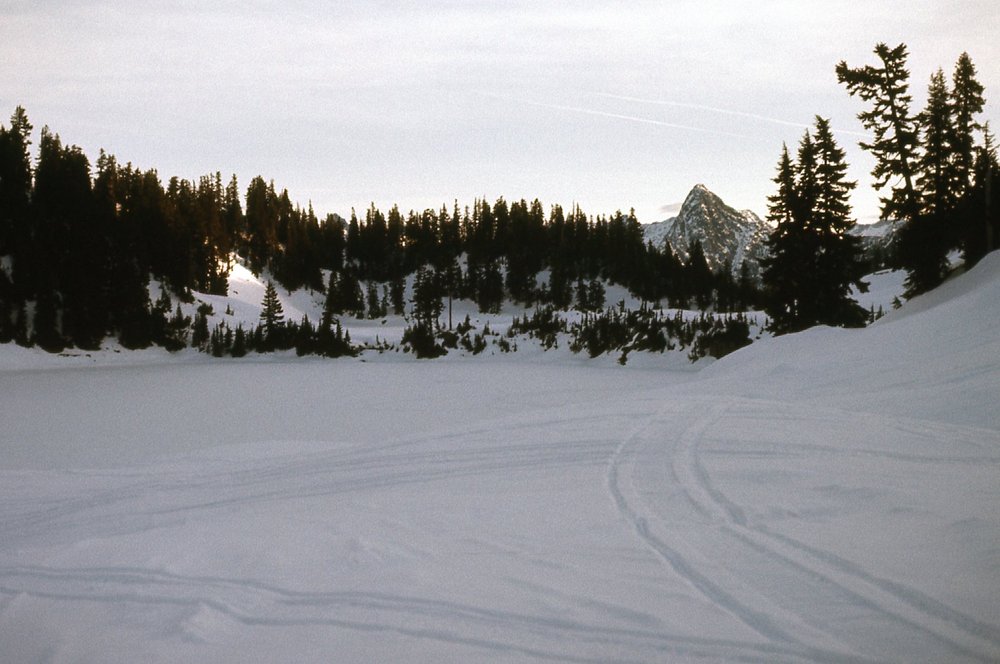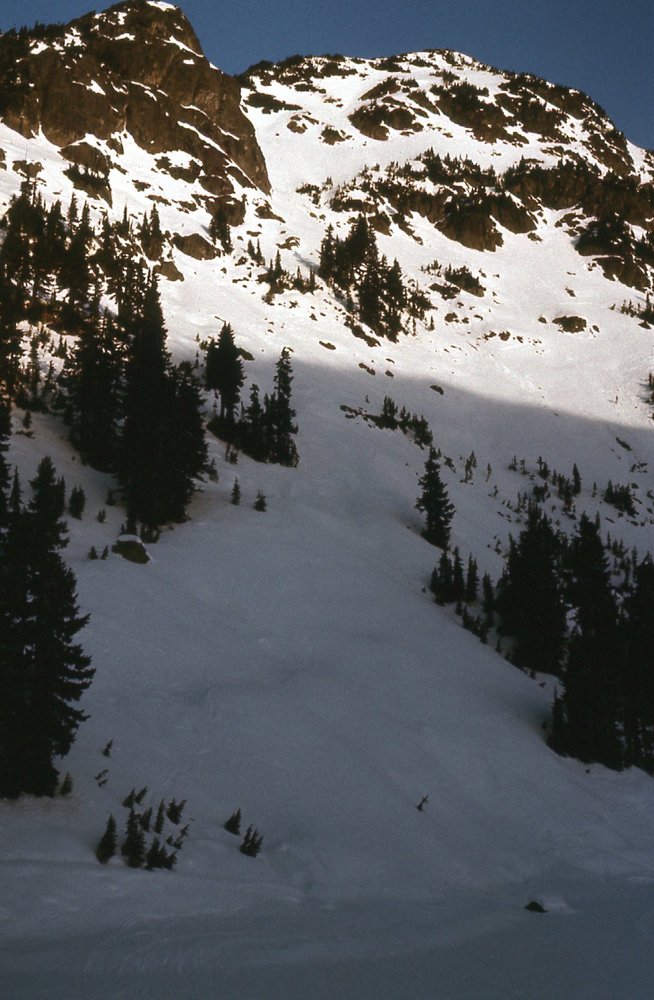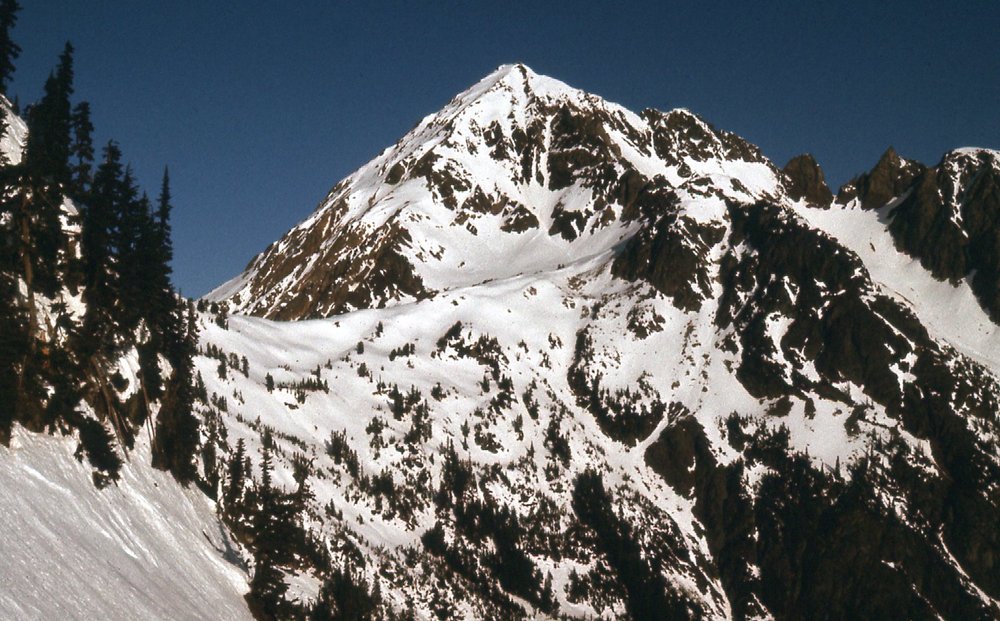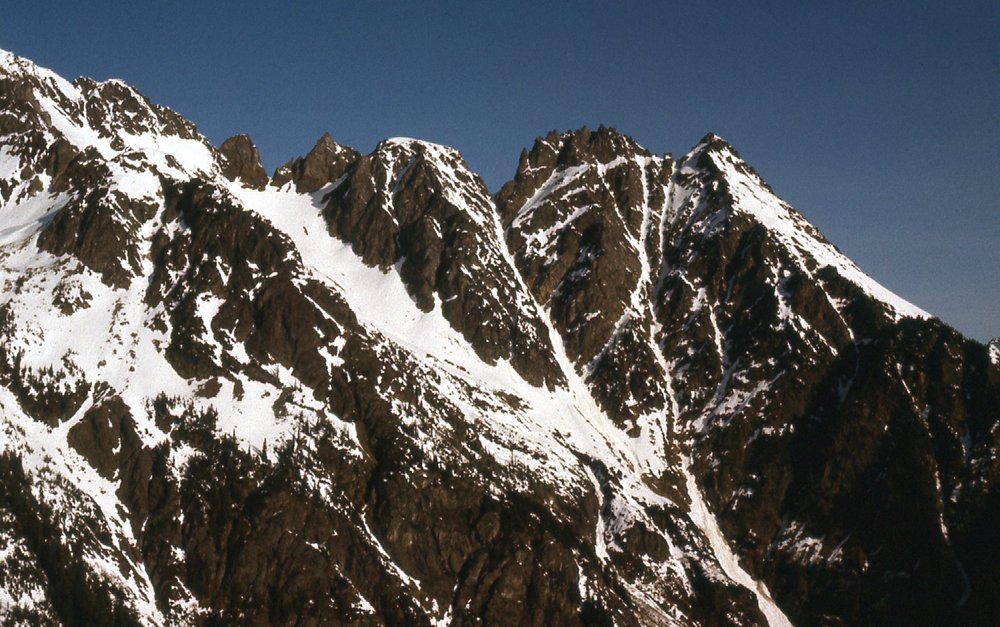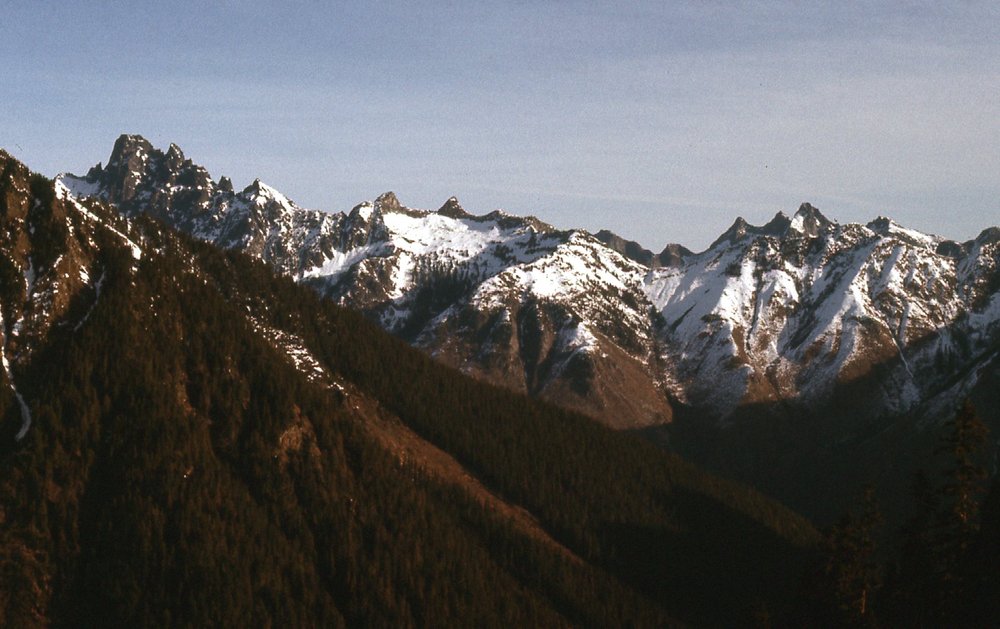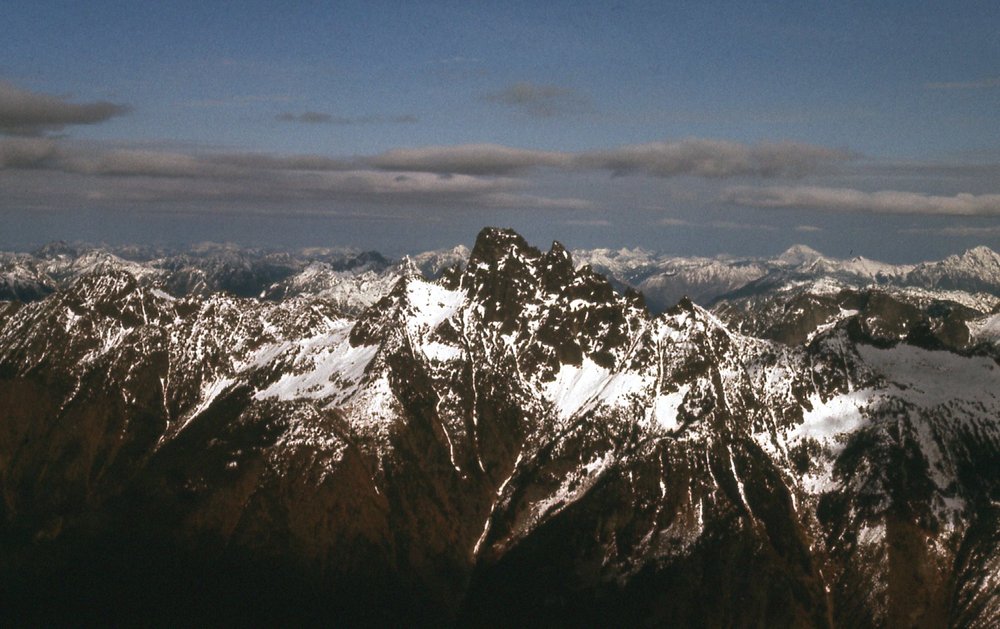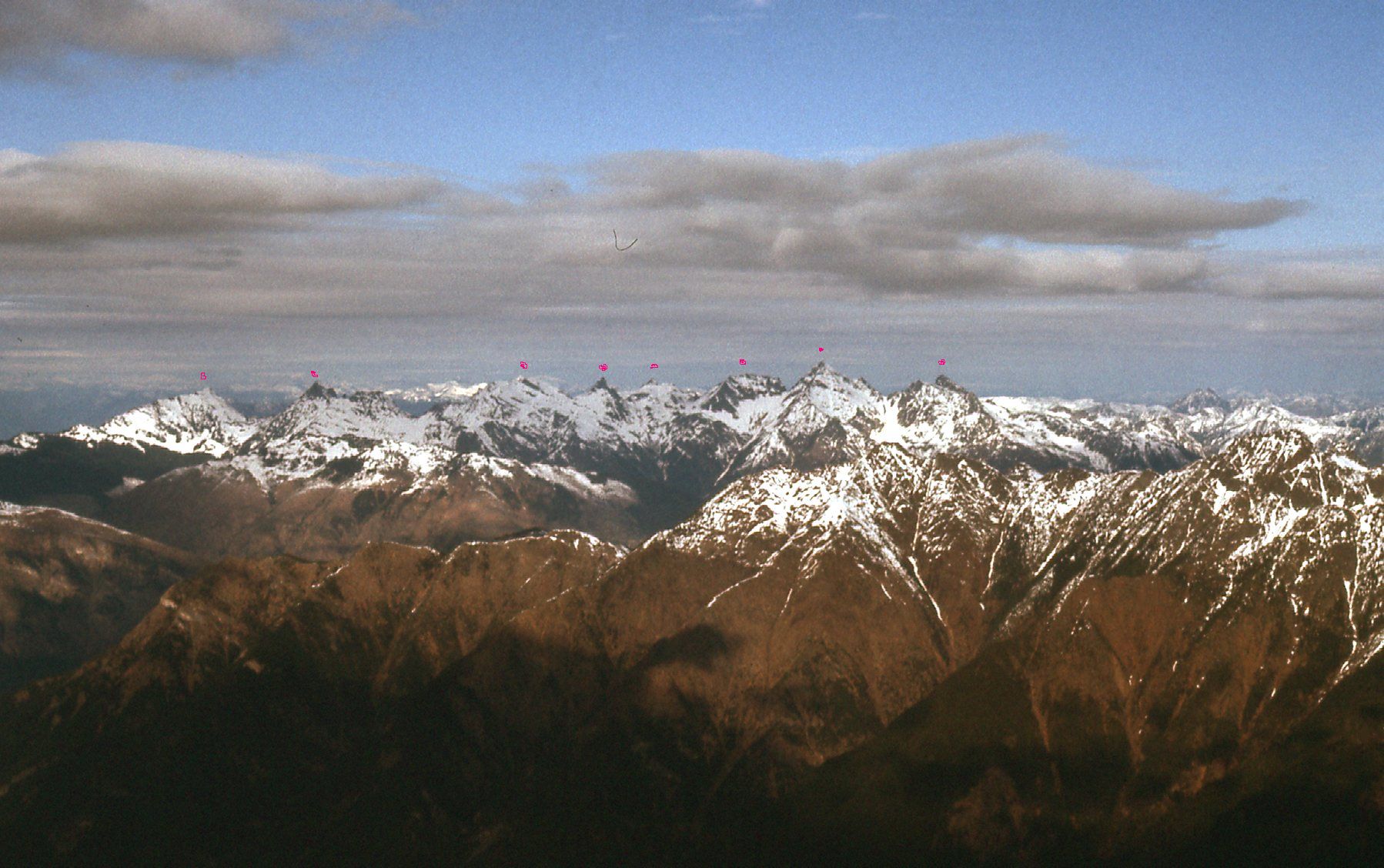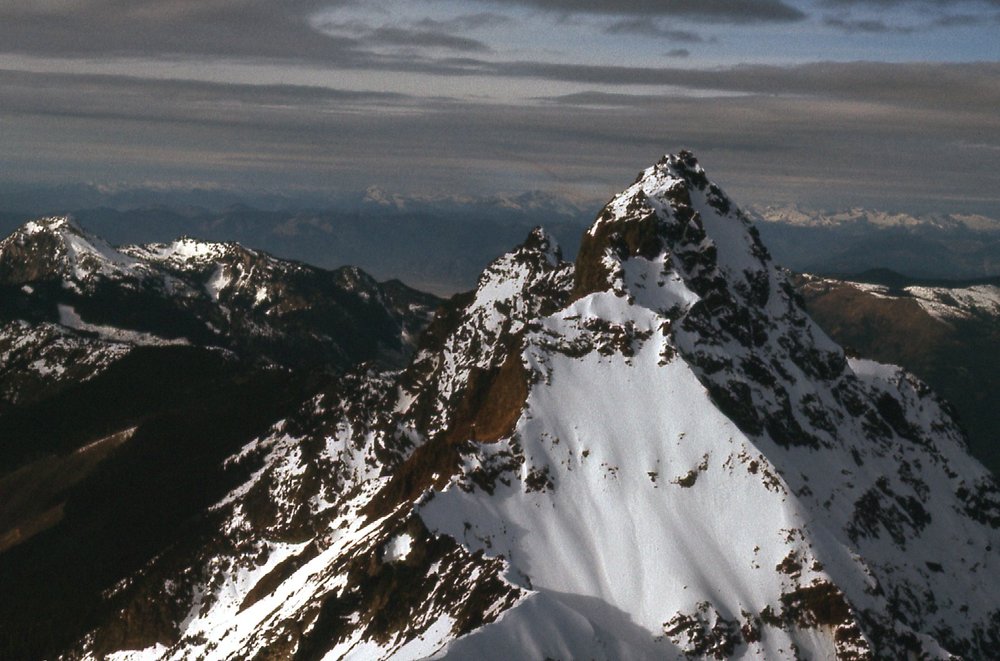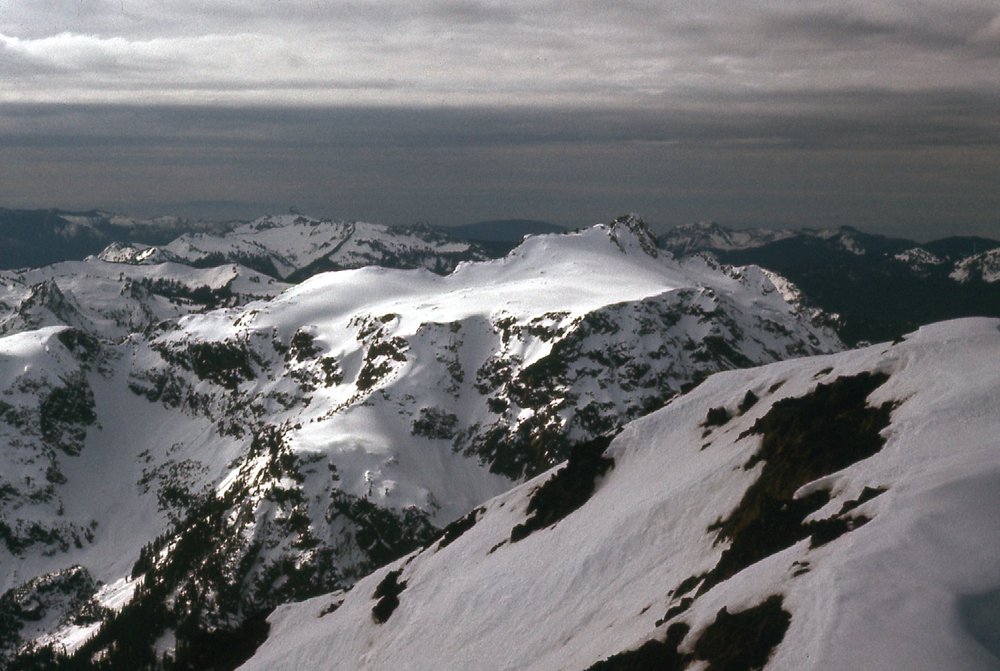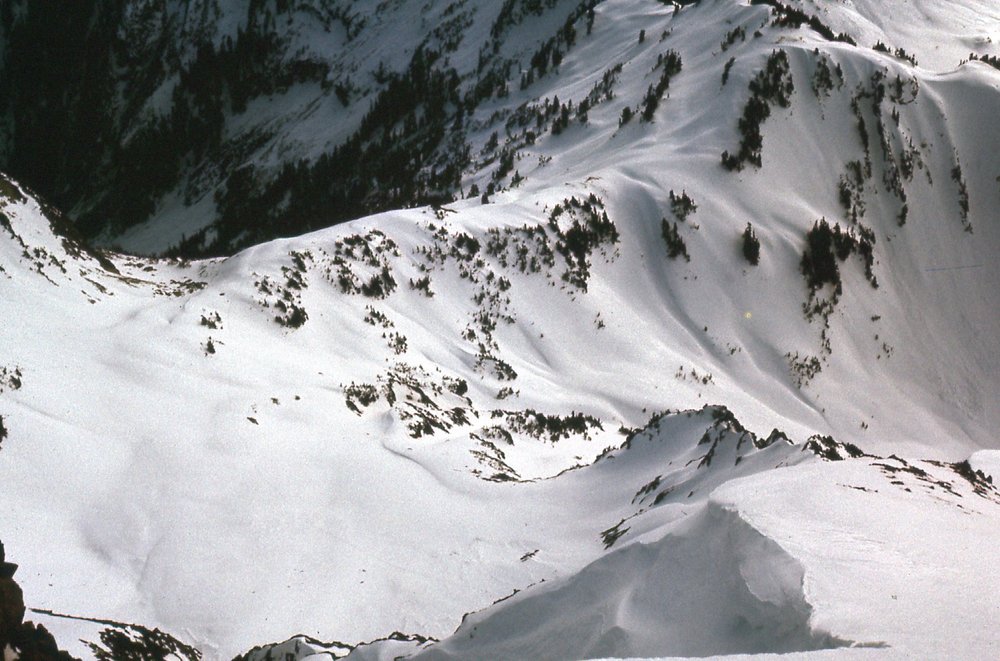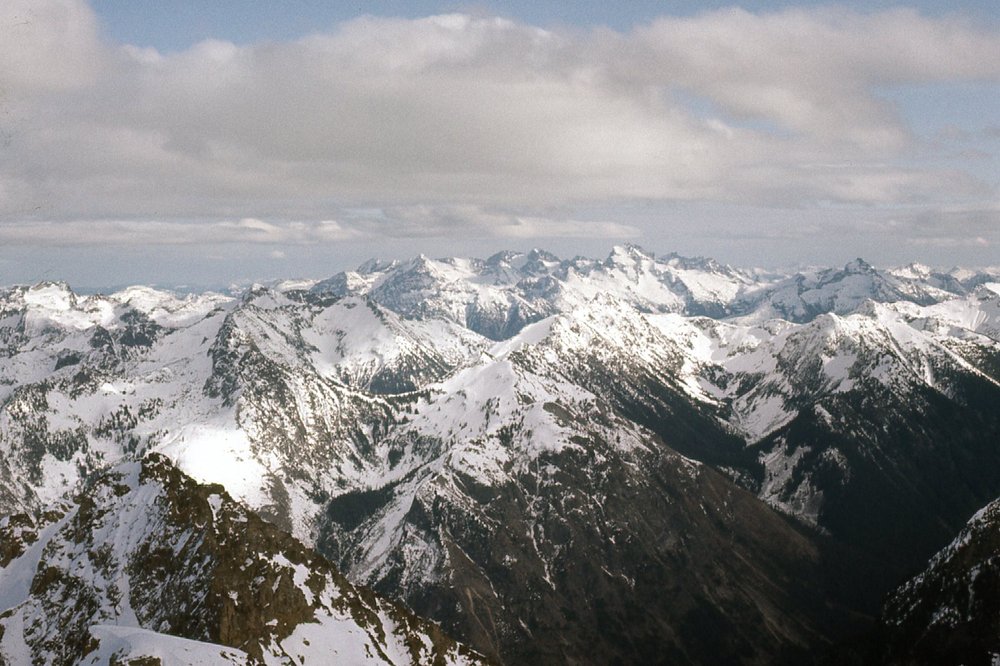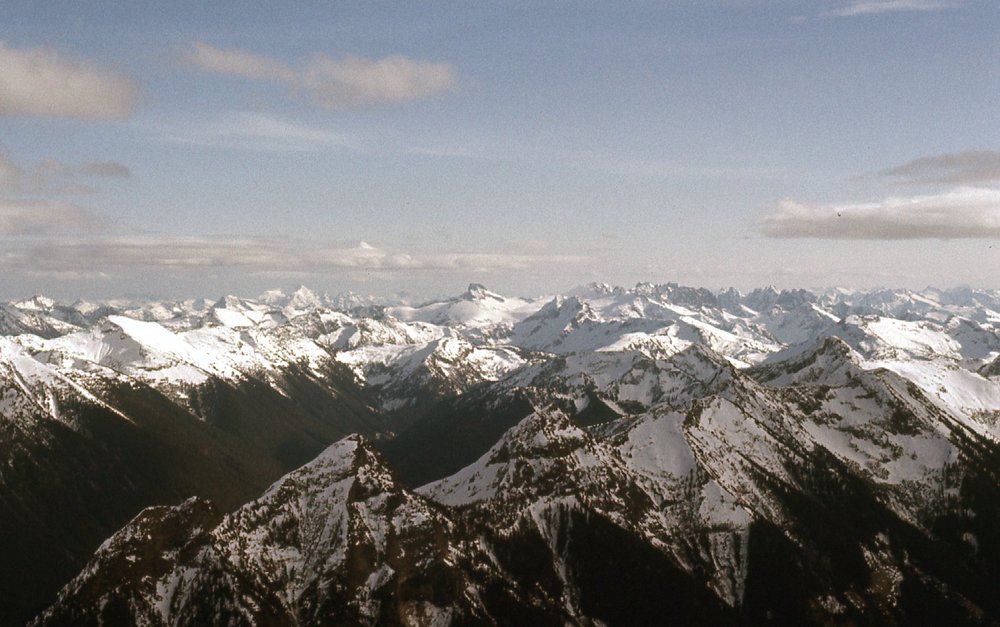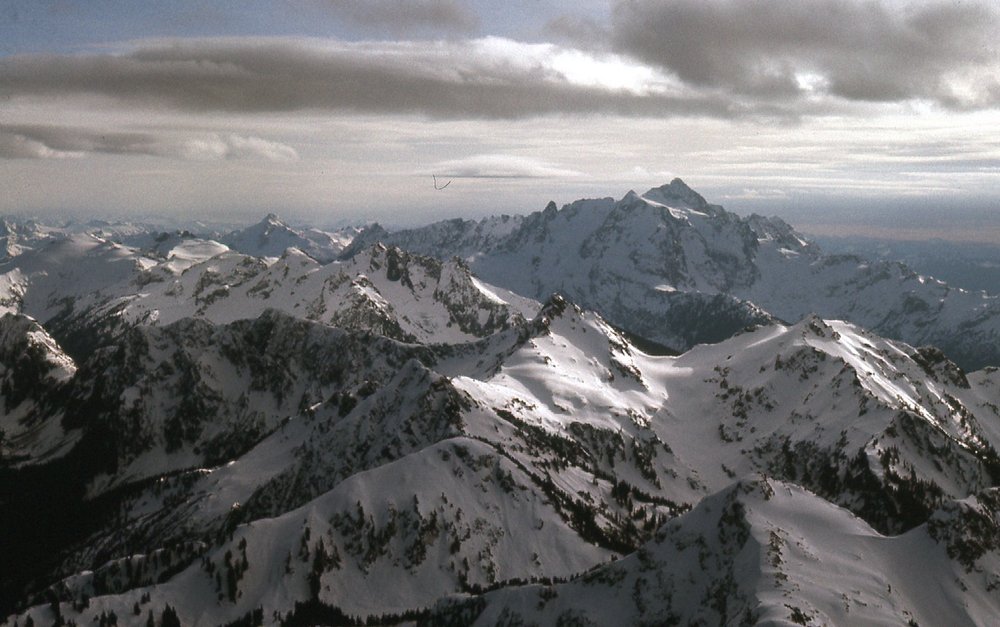If you’re lucky enough to climb in the northern part of Washington state, you’ll have your pick of many challenging peaks. Some of them may be in North Cascades National Park, but the one I want to tell you about today isn’t, not quite – it lies a few miles west of the park boundary, and about a mile and a half south of the Canadian border. It does lie, however, in the Mount Baker Wilderness. Mount Larrabee isn’t the tallest mountain in the area, but at 7,865 feet it holds its own among its neighbors.
My first exposure to that immediate area was on August 29th of 1976. On that day, I decided I’d go and climb Tomyhoi Peak. I was in a hurry, though, so I left my home in BC really early and drove to the border, then crossed, and 45 miles later I was at the turnoff where the dirt road began. A few more miles and I was parked by 6:00 AM. I lit out of there like a bat out of hell and stood on the summit of Tomyhoi Peak (elevation 7,435 feet) by 9:30 AM. Not bad for a 4,000-foot gain over 3.5 miles and a stiff Class 3 climb. Now that I knew the way, I made the return to my car in 2 hours flat. I was all the way back home in Canada in time for a 1:00 PM viewing of the Star Trek Sunday afternoon rerun while I ate my lunch with James T. Kirk. Peaks like Tomyhoi were so close to home for those of us who lived just north of the border that we could get to them quickly.
Because Tomyhoi Peak is only 3 miles west of Larrabee, climbing it afforded good views of Larrabee and its surroundings. Also, I had seen Larrabee many times from mountains in Canada just a few miles north of the border, so it is safe to say that my interest had been piqued. I’m not sure why I didn’t take advantage of the fine autumn weather to go and climb Larrabee soon after I did Tomyhoi, but the months slipped by and I didn’t go there until winter had set in.
Before I get into a description of the climb itself, I want to share with you some of the interesting topography around the mountain. Precipitation from the west side of the mountain drains into Tomyhoi Lake and then north into Tomyhoi Creek. When this creek crosses the border into Canada about 2 miles later, the Canucks call it Tamihi Creek. In any case, it flows northwest a number of miles until it enters the Chilliwack River.
The south and southeast sides of Larrabee are drained by Winchester Creek which flows east and soon joins Silesia Creek. Where Silesia accepts the waters of Winchester, it is already a force to be reckoned with. You see, Silesia has its roots many miles away to the southeast in North Cascades National Park, where it taps into the runoff from the likes of Hannegan Peak, Granite Mountain and Copper Mountain. Silesia Creek also flows northwest into Canada. It too undergoes a name change when it crosses the border – folks in the Great White North call it Slesse Creek. Slesse travels about 8 miles before it too is absorbed by the Chilliwack River.
On the north side of Larrabee sits a glacier which, although it has no official name, climbers call the Larrabee Glacier. About a thousand feet below the toe of the glacier sits the old Red Mountain Mine, which was in continuous operation from 1913 to 1942. They took a million dollars worth of gold out of the mine, and that was at the old historic prices. During its production years, the mine had a power plant on Silesia Creek, thousands of feet of phone and power transmission lines, several bunkhouses, an office, a stamp mill, and an aerial tramway. The mill burned in 1940 and no structures remain standing.
Working at the mine was not for the timid or faint-hearted. Meltwater from snowfields and glaciers above the mine poured through production stopes and raises 2 to 3 feet wide at a rate of 500 gallons per minute during the summer months. During winter months, avalanches shot by on both sides of the camp quarters. Labor turnover was as high as 96 percent in September of 1921. A 1937 report stated the following: “Labor turnover was so rapid that it required the proverbial three crews—one coming, one working, and one leaving—to keep the mine in operation. Not uncommonly, men arrived
and departed without having worked one full shift.” Aside from the isolation and difficult conditions, moving equipment and supplies purchased in the U.S. through Canadian customs provided an additional layer of complexity, and immigration laws prevented local Canadian labor from entering the U.S.
Historically, the easiest approach to the mine was from Chilliwack, B.C., by following logging roads leading south along Slesse Creek to border milepost 54. From the
milepost, an overgrown trail ascends a cleaver between two avalanche chutes to the mine. Several problems have arisen that make this approach currently unworkable. Both sides of the Slesse Creek road are impassable and the trail to the mine from milepost 54 switchbacks across the border several times. The border has alarms and is monitored by the U.S. Border Patrol. Attempts to obtain permission from U.S. Customs at Blaine, Washington for mine personnel to use the approach from Canada have been unsuccessful. So there you have it, the sad story of the Red Mountain Mine, a mine that has basically been prevented from doing business in recent times because of international politics. The approach through Canada made good sense, though, because the mine was only a thousand feet from the border.
Let’s get back to climbing Mount Larrabee – I took a long detour, didn’t I? The mountain was originally known as Red Mountain because of the striking red color of the rock, but the name was changed in 1951 to Mount Larrabee. Came February 8th (it was now 1977) and I talked my friend Mike into attempting a winter climb of the peak. We left Mission super-early and drove down to Washington state, then east on a state highway to the turnoff. We managed to drive all the way up to a trailhead at around 3,700 feet, but not beyond that because the land was deep in snow. There was an old road from that point which we could follow easily enough even though it was snow-covered. It crossed the mountainside above Swamp Creek until it reached 4,500 feet, then it switch-backed steeply up to 5,200 feet where we encountered what are known as Twin Lakes. They were completely frozen over.
A trail starts between the two small lakes and soon splits. The left branch goes up to a lookout on top of Winchester Mountain, elevation 6,510 feet.
Yes, there was a trail, but it was deeply buried under the snow and was of no use to us. We weren’t interested in climbing Winchester, so instead continued north – that took us around the east side of Winchester, then steeply uphill to what was called Low Pass at around 5,660 feet. We had a map, compass and altimeter and were using them to guide us, as the trail was completely buried and couldn’t be followed. What we had to do next was contour across the east side of Point 6131. I took this next picture as we crossed that slope. That’s Larrabee filling up the skyline. On the left, you can see a snow-filled saddle in the distance – that was our next goal. It is called High Pass at 5,940 feet.
We weren’t using skis or snowshoes, just our mountaineering boots, so it was heavy going at times, especially across slopes like the one in the lower left of the previous photo. From the same spot I took the above photo, I also took this one – it would sit on the right-hand edge of the above photo. It shows the ridge that heads east from the summit of Larrabee – this jagged feature is known as the Pleiades.
One more picture I took from the same spot shows Slesse Mountain in BC, and its long south ridge heading off to the right down towards the border.
We made it to High Pass, then continued by heading farther north and into a basin, where we had to drop down a bit, then continued on over and up to gain a ridge on the southwest side at around 6,900 feet. Even before this point, Mike complained of leg cramps and opted to wait while I went on. I came to a sort of face and found a gully which I climbed to gain the ridge again. This was followed, sometimes on one side or the other of the ridge crest, until I finally reached the summit at 7,861 feet. Everything was deep in snow so I didn’t find a register. I stopped long enough to take a bunch of summit photos, though, which I share with you here. This first one shows Slesse Mountain, elevation 7,969 feet, about 2 miles north of the border.
Here’s an excellent view I had of the entire Cheam Range, also in BC about 13 miles to the north. The thing I love about this photo is that it clearly shows all 8 peaks of the range in perhaps the best view I’ve ever captured. If you zoom in, you can see 8 red dots, one over each peak, and here they are from left to right: Cheam Peak; Lady Peak; Knight Peak; Baby Munday Peak; Stewart Peak; The Still; Welch Peak; Foley Peak.
More views from the top – here’s a great look at the Border Peaks. If you follow the ridge northwest from the summit of Larrabee, you will soon come to American Border Peak. It’s impressive, no matter from which direction you see it. Just to the left of it, a bit lower down from the summit, you can see another very sharp peak poking up behind its left shoulder – that’s the summit of Canadian Border Peak, and it’s no slouch either.
A look west along the summit ridge reveals Tomyhoi Peak, the one I mentioned way back at the beginning of this piece. It is the peak with the big sunlit snowfield in the upper center part of the photo. Nice, huh?
Here’s a look down the southeast ridge of Larrabee. Nothin’ but snow!
Here’s a look east to the Redoubt group of peaks, about 20 miles away on the horizon.
This next shot looks southeast to The Pickets.
The last one I have for you is a view south to Mt. Shuksan, about 11 miles distant.
As soon as I finished with my picture-taking, I started back down. It was easy to retrace my steps in the snow, being careful on the really steep bits, back down to where Mike still waited. Together, we plodded through the snow all the miles back to where the vehicle waited and drove back home. The only comments I made in my diary about the climb were that it was a very long day and that we got back home to Mission very late. It helped a lot that the Sumas border crossing has always been open 24/7. In hindsight, Larrabee was one of the more enjoyable winter climbs I did in those days. Thanks for keeping me company.

